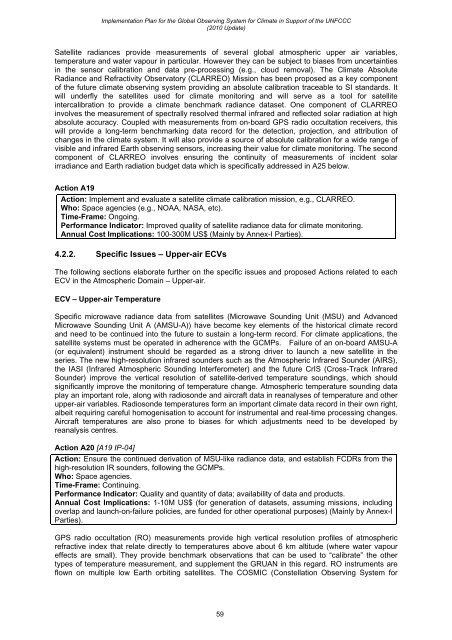GCOS Implementation Plan - WMO
GCOS Implementation Plan - WMO
GCOS Implementation Plan - WMO
You also want an ePaper? Increase the reach of your titles
YUMPU automatically turns print PDFs into web optimized ePapers that Google loves.
<strong>Implementation</strong> <strong>Plan</strong> for the Global Observing System for Climate in Support of the UNFCCC<br />
(2010 Update)<br />
Satellite radiances provide measurements of several global atmospheric upper air variables,<br />
temperature and water vapour in particular. However they can be subject to biases from uncertainties<br />
in the sensor calibration and data pre-processing (e.g., cloud removal). The Climate Absolute<br />
Radiance and Refractivity Observatory (CLARREO) Mission has been proposed as a key component<br />
of the future climate observing system providing an absolute calibration traceable to SI standards. It<br />
will underfly the satellites used for climate monitoring and will serve as a tool for satellite<br />
intercalibration to provide a climate benchmark radiance dataset. One component of CLARREO<br />
involves the measurement of spectrally resolved thermal infrared and reflected solar radiation at high<br />
absolute accuracy. Coupled with measurements from on-board GPS radio occultation receivers, this<br />
will provide a long-term benchmarking data record for the detection, projection, and attribution of<br />
changes in the climate system. It will also provide a source of absolute calibration for a wide range of<br />
visible and infrared Earth observing sensors, increasing their value for climate monitoring. The second<br />
component of CLARREO involves ensuring the continuity of measurements of incident solar<br />
irradiance and Earth radiation budget data which is specifically addressed in A25 below.<br />
Action A19<br />
Action: Implement and evaluate a satellite climate calibration mission, e.g., CLARREO.<br />
Who: Space agencies (e.g., NOAA, NASA, etc).<br />
Time-Frame: Ongoing.<br />
Performance Indicator: Improved quality of satellite radiance data for climate monitoring.<br />
Annual Cost Implications: 100-300M US$ (Mainly by Annex-I Parties).<br />
4.2.2. Specific Issues – Upper-air ECVs<br />
The following sections elaborate further on the specific issues and proposed Actions related to each<br />
ECV in the Atmospheric Domain – Upper-air.<br />
ECV – Upper-air Temperature<br />
Specific microwave radiance data from satellites (Microwave Sounding Unit (MSU) and Advanced<br />
Microwave Sounding Unit A (AMSU-A)) have become key elements of the historical climate record<br />
and need to be continued into the future to sustain a long-term record. For climate applications, the<br />
satellite systems must be operated in adherence with the GCMPs. Failure of an on-board AMSU-A<br />
(or equivalent) instrument should be regarded as a strong driver to launch a new satellite in the<br />
series. The new high-resolution infrared sounders such as the Atmospheric Infrared Sounder (AIRS),<br />
the IASI (Infrared Atmospheric Sounding Interferometer) and the future CrIS (Cross-Track Infrared<br />
Sounder) improve the vertical resolution of satellite-derived temperature soundings, which should<br />
significantly improve the monitoring of temperature change. Atmospheric temperature sounding data<br />
play an important role, along with radiosonde and aircraft data in reanalyses of temperature and other<br />
upper-air variables. Radiosonde temperatures form an important climate data record in their own right,<br />
albeit requiring careful homogenisation to account for instrumental and real-time processing changes.<br />
Aircraft temperatures are also prone to biases for which adjustments need to be developed by<br />
reanalysis centres.<br />
Action A20 [A19 IP-04]<br />
Action: Ensure the continued derivation of MSU-like radiance data, and establish FCDRs from the<br />
high-resolution IR sounders, following the GCMPs.<br />
Who: Space agencies.<br />
Time-Frame: Continuing.<br />
Performance Indicator: Quality and quantity of data; availability of data and products.<br />
Annual Cost Implications: 1-10M US$ (for generation of datasets, assuming missions, including<br />
overlap and launch-on-failure policies, are funded for other operational purposes) (Mainly by Annex-I<br />
Parties).<br />
GPS radio occultation (RO) measurements provide high vertical resolution profiles of atmospheric<br />
refractive index that relate directly to temperatures above about 6 km altitude (where water vapour<br />
effects are small). They provide benchmark observations that can be used to “calibrate” the other<br />
types of temperature measurement, and supplement the GRUAN in this regard. RO instruments are<br />
flown on multiple low Earth orbiting satellites. The COSMIC (Constellation Observing System for<br />
59
















